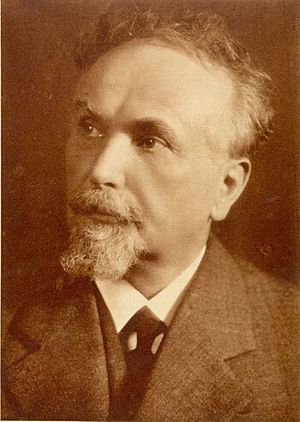Ivan Regen facts for kids
Quick facts for kids
Ivan Regen
|
|
|---|---|
 |
|
| Born | December 9, 1868 Lajše, Austria–Hungary (now Slovenia)
|
| Died | July 27, 1947 (aged 78) |
| Nationality | Slovene |
| Alma mater | University of Vienna |
| Known for | establishing modern bioacoustics |
| Scientific career | |
| Fields | animal physiology, bioacoustics, geobiology |
| Academic advisors | Karl Grobben, Sigmund Exner, Carl Friedrich Wilhelm Claus |
| Influences | Karl Grobben |
Ivan (Janez) Regen (called Johann Regen) (December 9, 1868 – July 27, 1947), was a Slovenian biologist. He is best known for his studies in bioacoustics, the science of hearing and communicating.
Early life
Regen was born in the village of Lajše (now Slovenia). His mother encouraged his interest in insect sounds. His father lost a lot of money bring cloth into Slovenia and could not pay for Ivan to go to school. Ivan was given a scholarship so that he could go to school at the local seminary. He was able to save enough money go to study in Vienna. He studied natural history at the University of Vienna with teachers Grobben, Exner and Claus. He got his doctorate in 1897 and began to work as a school teacher in Vienna, and later in Hranice, Moravia. Exner helped him get a job back in Vienna. He worked in a secondary school there until his retirement in 1918.
Research
Regen began to study insects in great detail. He was one of the first Slovenian scientists to work in another country after World War I. He was the first scientist to study the grasshopper in a lot of detail. He studied katydid and cricket sounds, he proved that insects did react to sounds from each other. He was able to make crickets react to artificial sounds using a loudspeaker. In one experiment, he used a telephone to send sounds from one cricket to another in different rooms. Later, he showed that insects hear with their ear drum. He was the first person to work out what the ear drum does. He is the person who started the study of bioacoustics. He also studied the insects breathing, their hibernation, coloring, and how they shed their skin.
Regen's largest project was his "geobiological laboratory", a large glass cage, called a terrarium. He used this to study the way crickets could find other crickets using sounds; this is called phonotaxis. Using up to 1600 females with normal or damaged hearing, he was able to work out how they did this.
He worked for himself after 1911, but he supported several groups and organizations in Slovenia. He started using Slovene terminology in his areas of study. In 1921, he was asked to be a professor at the University of Ljubljana, but did not take it. In 1940, he became a member of Slovenian Academy of Sciences and Arts and was also a member of Slovenian Society of Natural History.
Even though he was a famous scientist known around the world, he was poor and lived alone. His experiments were paid for by the Austrian Academy of Sciences, but he was not allowed to be a member. He did all his work at home. After his death, a lot of his special equipment such as microphones, oscilloscopes, galvanometer, and his written notes were destroyed.
See also
 In Spanish: Ivan Regen para niños
In Spanish: Ivan Regen para niños

